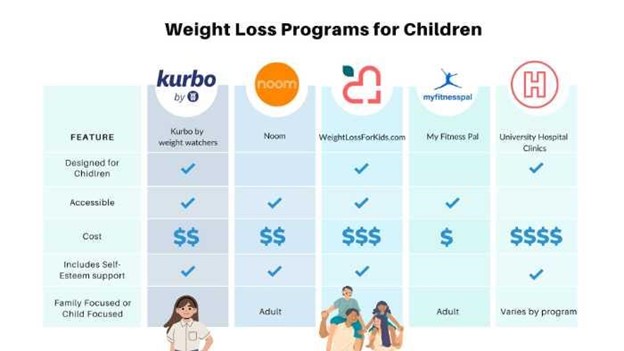By Natasha Agbai, MD
Losing weight is hard enough for adults, but when it comes to kids, the stakes are even higher. Kids are still growing and developing, so they need to be especially careful when it comes to dieting and exercise. n this blog post, we will discuss some of the things you need to look for when choosing a weight loss program for your son or daughter, as well as ways to stay safe during the process. We’ll also take a look at some of the most popular programs out there and see how they stack up in terms of safety and effectiveness.
There are many risks associated with children being overweight, including type II diabetes, high blood pressure, sleep apnea, and joint problems. In fact, children with obesity are more likely to become adults with obesity, which can lead to even more serious health problems down the road. However, there are also risks associated with weight loss programs for children. If not done in a thoughtful, developmentally appropriate way, focus on weight risks the development of weight fixations, yo-yo dieting, and even weight obsessions and eating disorders. Lack of nutrients can occur and weight loss during critical periods of development can interfere with puberty and growth. It is important to find a balance between the risks and the benefits when it comes to children and weight.
Ignoring a child’s weight concern is also unwise. According to a study by Common Sense Media, 80% of 10-year-old girls have been on a diet, and 50% of 10-year-old girls want to be thinner. So even if a parent doesn’t want to think about weight, I urge you to have an open discussion and see where your child is. Parents can guide their teens toward health by slowly changing eating habits. These habits established in youth grow and become stronger in teens.
What to look for in weight loss programs for children
When looking for a weight management program for children, there are several things you should keep in mind. First and foremost, safety is always the number one priority. Make sure the program is run by qualified medical professionals who can supervise your child during the process. Second, look for a program that is developmentally appropriate for your child’s age and stage.
Any program should have reasonable recommendations for physical activity and healthy eating habits and include parents and caregivers, not just be focused on the child. Complete nutrition without excessive restriction for the whole family should be encouraged. Progress and goals should be re-evaluated over time. Healthier choices should be encouraged, but perfection discouraged.
What weight loss programs exist for children?
There are limited resources for kids who wish to lose weight. Many programs are designed for adults and then modified for children and adolescents, or in worse cases, just applied to children without taking into consideration family-based techniques, and the unique developmental needs of children and adolescents. If you are looking for a pediatric weight program, also determine if you want the focus to be on the family or on the child.
Commercial Apps and programs
Popular adult programs include Noom or trackers like myfitnesspal are easy for children to find, and parents may be unaware that people in their families have joined a program.
One of the most popular children’s weight loss programs is called Kurbo by weight watchers. It uses the traffic light system which categorizes foods as healthy (such as fruits and vegetables), yellow (healthier foods that require watching your portion size), and red foods (less healthy treats) that need to be budgeted to see progress. Kids meet regularly with their coach to work on their habits.
Hospital-based programs
Shapedown is a program offered in Canada that is family-based involves a no-diet holistic approach with group meetings and a led by a multidisciplinary team
Some children’s hospitals have comprehensive pediatric weight programs that follow evidence-based medicine to help children eat healthier, exercise more and lose weight. When effective, these amazing changes can last a lifetime. In a hospital-based program, the doctor, parents, and child can work together to set goals. Some may even work with the local school on an education program. Unfortunately, many families are finding that the wait times at their local hospital program may be unexpectedly long, and while waiting for the program to begin, a child’s concerns continue to climb.

How can families promote healthy weight and eating habits without making it a big(ger) deal?
Parents and kids must have regular communication about important issues affecting their children and yes, even though this can feel uncomfortable, a brief conversation may help prevent a child from trying to lose weight by restrictive eating, excessive physical activity or even, unsafe pills or binging and purging. Don’t assume that your child doesn’t have questions about the shape of their bodies – most do!
Here are some tips to bring up some uncomfortable conversations.
- Avoid having a conversation about healthy foods or portion sizes while eating. This can cause a person to feel judged. If you notice an unhealthy behavior, bring it up another time.
- Use “I noticed” statements when sharing your concerns. For example, “I noticed that you don’t want to go swimming, can you tell me about what is going on?”
- If your son or daughter is teased for their body shape or size, express empathy WITHOUT offering a solution. “That must have hurt. Teasing someone about their weight is wrong and I’m sorry that happened.” At a completely separate and unrelated conversation, you could brainstorm suggestions for improved health habits. Remember. Provide support, not advice.
Here are some tips to establish healthy habits
- If you make a change in the way your family chooses to eat, ensure that the change is sustainable. Overly aggressive goals are often not successful in the long run, and may even set up your family for unhealthy behaviors.
- Encourage children to be active every day. This could include walking the dog with you, riding bikes together, or playing tag in the park. Exercise has to be fun for it to be lasting.
- Make sure that everyone in the family has a say about what they eat for meals and snacks. Allowing each family member to contribute to meal planning helps each person feel valued.
- Focus on behaviors, not weight loss. Setting a goal of choosing fruit for snacks will be more effective and easier to follow and track than setting a goal of losing 5 pounds.
 Natasha Agbai, MD is a pediatrician and founder of a family-based weight loss program.
Natasha Agbai, MD is a pediatrician and founder of a family-based weight loss program.
